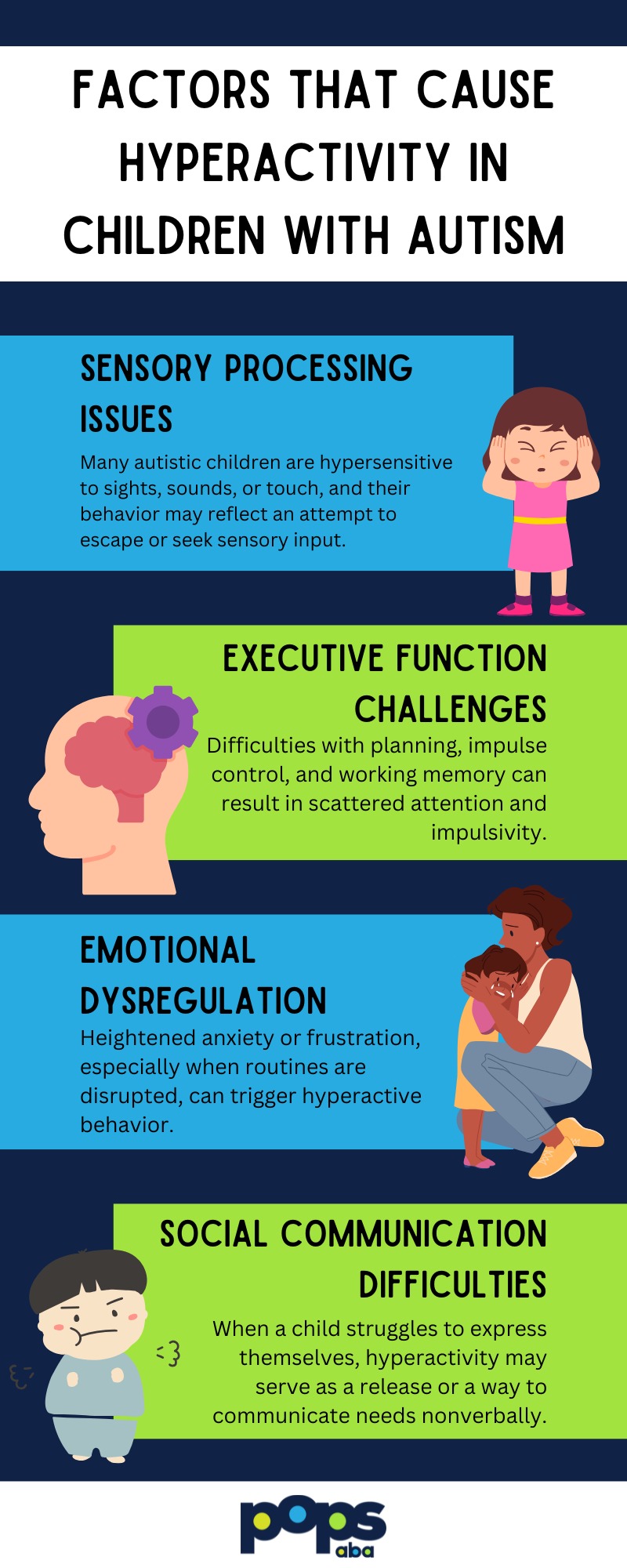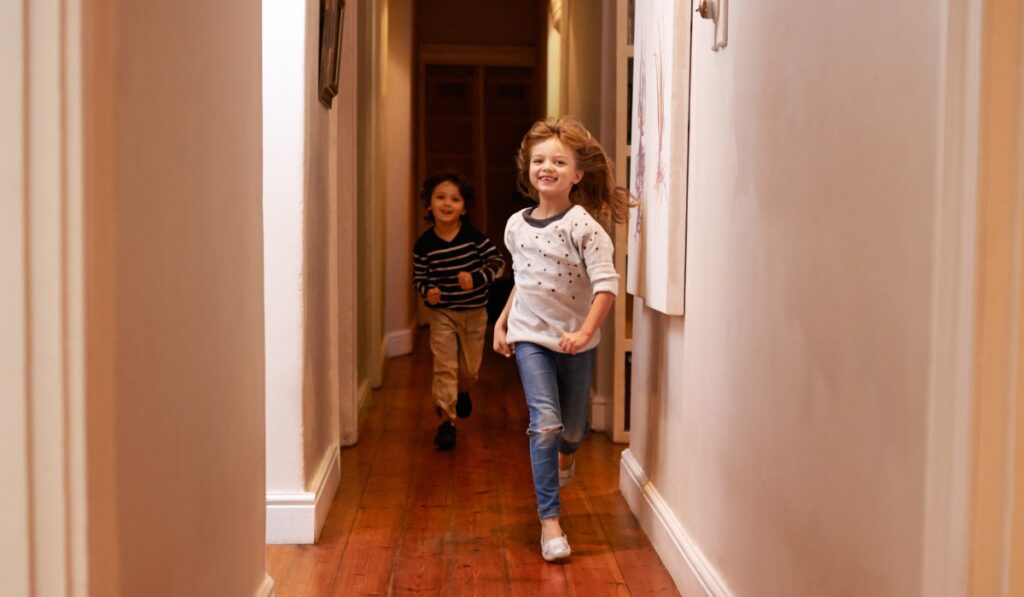Key Points:
- Hyperactivity is common in autistic children but isn’t exclusive to autism and can overlap with ADHD traits.
- Understanding behavioral triggers, such as sensory overload and executive function challenges, helps manage hyperactivity.
- ABA therapy offers structured, evidence-based strategies to address hyperactivity in children with autism.
According to research, up to 70% of individuals with autism also display symptoms of ADHD, including hyperactivity. While hyperactivity is often associated with ADHD, it’s also common in autistic children and can present in unique ways that differ from typical attention difficulties.
Understanding how and why hyperactivity occurs in autism is crucial for parents seeking to support their child’s emotional regulation, focus, and behavior. In this article, we’ll explore the signs, symptoms, and causes of hyperactivity in autistic children, how it differs from ADHD, and evidence-based strategies—like ABA therapy—that can make a real difference at home and in school.
Is Hyperactivity a Sign of Autism?
Yes, hyperactivity can be a sign of autism, but it is not exclusive to it. Many autistic children show hyperactive behaviors, especially those who also meet criteria for ADHD. However, not every child with autism is hyperactive, and not every hyperactive child is autistic. The presence of hyperactivity should be considered alongside other symptoms of autism spectrum disorder (ASD).
Hyperactivity in autism often involves excessive movement, difficulty sitting still, impulsive actions, or frequent switching between activities. While this overlaps with ADHD, the root causes and emotional triggers can differ when a child is on the spectrum.
How is Hyperactivity Displayed in Autistic Children?
Hyperactivity in autistic children can look different from what’s seen in children with only ADHD. Rather than impulsivity driven by external distractions, autistic children may act out due to internal dysregulation, sensory overload, or anxiety. Understanding these patterns can help parents respond in a supportive and informed way.
While these signs can vary from child to child, they often reflect unmet sensory, emotional, or cognitive needs. Rather than assuming disobedience, it helps to consider what the behavior is trying to communicate.
What Causes Hyperactivity in Children with Autism?
The causes of hyperactivity in autism are layered and often involve a combination of neurological, sensory, and behavioral factors. Unlike ADHD, where hyperactivity is more neurologically driven, in autism, hyperactivity often reflects an attempt to self-regulate in a world that feels overwhelming or unpredictable.
Here are common contributing causes:

Understanding the root of a child’s hyperactivity helps guide appropriate interventions and avoid mislabeling or unnecessary discipline.
How Can Parents Tell the Difference Between ADHD and Autism-Related Hyperactivity?
Parents often notice hyperactivity but may struggle to determine whether it’s related to ADHD, autism, or both. ADHD-driven hyperactivity typically stems from impulsivity and distractibility, with children showing a strong desire for interaction but difficulty managing their focus or actions. In contrast, hyperactivity in autism is often triggered by sensory overload, anxiety, or a need for routine.
Autistic children may display repetitive behaviors or intense focus on narrow interests, while those with ADHD are more scattered and reactive. Understanding the cause of hyperactivity helps guide proper support. A comprehensive evaluation by a specialist is crucial to clarify the diagnosis and next steps.
Common Signs of Hyperactivity in Autism
When hyperactivity shows up alongside autism, it may take on unique traits that distinguish it from generalized restlessness. It’s important to watch out for the common signs in order to get the right intervention early on. Here’s a breakdown of what to watch for:
1. Excessive Fidgeting
Frequent tapping, twirling, or finger movements can signal a need for sensory input or help with self-regulation.
2. Inability to Sit Still
Struggles to remain seated during meals, class, or routines often stem from sensory or emotional discomfort.
3. Constant Motion
Pacing, climbing, or aimless running may reflect internal unrest or attempts to manage overstimulation.

4. Interrupting or Talking Rapidly
Rapid or repetitive speech can arise from excitement, anxiety, or difficulty processing conversational flow.
5. Difficulty Transitioning
Sudden changes in activity or setting may trigger restlessness, outbursts, or resistance due to rigid routines.
6. Sensory-Seeking Behaviors
Behaviors like spinning or seeking tight hugs often fulfill sensory needs and help soothe the nervous system.
7. Impulsive Behavior
Quick, unplanned actions—like bolting or grabbing—can signal challenges with impulse control or emotional regulation.
Not every child will display all of these, and intensity can vary depending on the environment, emotional state, and time of day.
Strategies to Support Hyperactive Autistic Children at Home
Managing hyperactivity at home requires structure, patience, and a good understanding of your child’s triggers. The goal isn’t to “eliminate” the hyperactivity but to redirect it in healthy, regulated ways.
Here are actionable tips for parents:
1. Use Visual Supports
Timers, picture charts, and visual checklists assist with transitions and help improve focus and understanding.
2. Create a Sensory-Friendly Environment
Quiet spaces, weighted blankets, or headphones minimize overstimulation and support self-regulation at home.
3. Provide Movement Breaks
Frequent chances to move—like jumping or dancing—can redirect excess energy into healthy, structured outlets.
4. Use Positive Reinforcement
Rewarding calm behavior builds motivation and reinforces desirable actions more effectively than punishment.
5. Limit Screen Time
Reducing screen exposure helps prevent overstimulation and promotes better sleep and focus.
6. Practice Self-Regulation Skills
Breathing exercises, fidget tools, or calming jars teach children how to manage big emotions more independently.
Consistency is key. Over time, these strategies can help children gain more control over their energy and behavior.
When Should Parents Seek Professional Help?
Some hyperactivity in children is developmentally normal. However, when it becomes disruptive, persistent, or affects daily functioning, it’s time to seek guidance. If hyperactivity interferes with school, home life, sleep, or peer relationships, professional intervention may be needed.
Red flags to watch for include:
- Hyperactivity causes frequent meltdowns or injuries.
- Difficulty sleeping due to excessive movement or restlessness.
- Increasing aggression, anxiety, or withdrawal.
- Difficulty participating in group activities or structured environments.
An early evaluation can identify co-occurring ADHD, sensory processing disorder, or behavior patterns consistent with autism. Early intervention matters and can lead to much better outcomes.
How ABA Therapy Supports Children with Autism and Hyperactivity
Applied Behavior Analysis (ABA) is a structured, evidence-based approach to helping children with autism develop functional skills and reduce disruptive behaviors. For hyperactive children, ABA focuses on understanding the “why” behind the behavior and replacing it with more adaptive responses.
ABA also includes parent training, so families can reinforce strategies at home. Over time, children learn how to manage their energy in a way that supports learning, socialization, and emotional growth. Since many of these challenges are tied to sensory processing, you may find our article Hypersensitivity in Autism: Common Examples and Types helpful for understanding how sensory issues influence behavior.
Foster Lifelong Learning With ABA Therapy
If your child is experiencing hyperactivity alongside autism symptoms, ABA therapy can provide structured support tailored to their individual needs. Pops ABA offers compassionate, evidence-based ABA therapy in North Carolina and New Jersey, focusing on skill-building, self-regulation, and improved daily functioning.
Our team works directly with families to create a customized plan that supports your child’s unique behavioral profile and goals. Contact us today to learn more about how ABA therapy with Pops ABA can help your child thrive at home, at school, and in the community.



